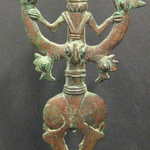Luristan Standard Finial Depicting a Master of the Beasts, 900 BCE - 600 CE
Bronze
3.5 x 6.875
FZ.099
Luristan (or Lorestan) literally means “Land of the Lurs”, and was situated in a wide sweep of the Zagros mountains in what is now western Iran. The sociopolitics of this...
Luristan (or Lorestan) literally means “Land of the Lurs”, and was situated in a wide sweep of the Zagros mountains in what is now western Iran. The sociopolitics of this area are complex, with repeated waves and invasions of Medes, Cimmerians and Persians, amongst others, but the culture thus created is remarkable for its superb control of metalworking. There are many styles, but the best-known pieces of bronze from this area are anthropomorphic and zoomorphic pieces reflecting religious and secular tastes, as well as weaponry and utilitarian items that were buried with the deceased in tombs across the Zagros area. It was nonetheless viewed as a precious resource, and was used alongside iron once this metal became available, for while its qualities of hardness and durability were recognized, it merely made bronze a more socially exclusive material. The hallmark of Luristan wares is the tendency to elongate the necks, tails and bodies of the animals to produce graceful curves and arches. The re-discovery of the splendor of Luristan metalwork began in the 1930s and made considerable progress after World War II. The absence of relevant written records makes their complex imagery difficult to interpret in specific religious terms but it is likely that they represent local deities of some kind. It has been suggested that such elaborate bronze items must have been the preserve of the tribal leaders, a warrior class with the means to equip themselves and their households for war.
The exact interpretation of the complex mythology of these bronze finials is uncertain, but their hypnotic beauty continues to fascinate. A central deity with beaked features like an eagle springs from the head of another similar figure and grasps the necks of two fearsome monsters that heraldically threaten him. We do not need to know the details of the story to experience the awesome visual and emotional power of such works. They speak a universal language, something primal and very ancient.
The exact interpretation of the complex mythology of these bronze finials is uncertain, but their hypnotic beauty continues to fascinate. A central deity with beaked features like an eagle springs from the head of another similar figure and grasps the necks of two fearsome monsters that heraldically threaten him. We do not need to know the details of the story to experience the awesome visual and emotional power of such works. They speak a universal language, something primal and very ancient.
Literature
V1



